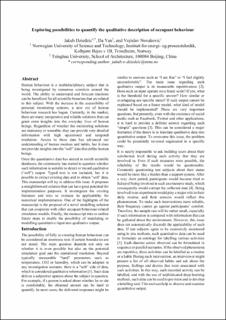| dc.contributor.author | Dziedzic, Jakub Wladyslaw | |
| dc.contributor.author | Da, Yan | |
| dc.contributor.author | Novakovic, Vojislav | |
| dc.date.accessioned | 2021-06-11T12:33:26Z | |
| dc.date.available | 2021-06-11T12:33:26Z | |
| dc.date.created | 2020-10-21T10:03:58Z | |
| dc.date.issued | 2020 | |
| dc.identifier.isbn | 978-82-536-1679-7 | |
| dc.identifier.uri | https://hdl.handle.net/11250/2759002 | |
| dc.description.abstract | Human behaviour is a multidisciplinary subject that is being investigated by numerous scientists around the world. The ability to understand and forecast reactions can be beneficial for all scientific branches that are related to this subject. With the increase in the accessibility of personal monitoring systems, a new era of human behaviour research has begun. Currently, in the market, there are many inexpensive and reliable solutions that can grant extra insights into the everyday lives of human beings. Regardless of whether the monitoring solutions are stationary or wearable, they can provide very detailed information with high operational and temporal resolution. Access to these data has advanced our understanding of human routines and habits, but it does not provide insights into the “soft” data that define human beings.
Once the quantitative data has started to enrich scientific databases, the community has started to question whether such information is suitable to detect or record qualitative (“soft”) output. Typed text is not included, but it is possible to extract existing data and to obtain “soft” data. This manuscript will try to address this issue. It proposes a straightforward solution that can have great potential for implementation purposes. It investigates the existing literature and tries to evaluate its applicability for numerical implementation. One of the highlights of the manuscript is the proposal of a novel modelling solution that can cooperate with other occupant behaviour-related simulation models. Finally, the manuscript tries to outline future steps to enable the possibility of translating or modelling quantitative input into qualitative output. | en_US |
| dc.language.iso | eng | en_US |
| dc.publisher | SINTEF akademisk forlag | en_US |
| dc.relation.ispartof | International Conference Organised by IBPSA-Nordic, 13th–14th October 2020, OsloMet. BuildSIM-Nordic 2020. Selected papers | |
| dc.rights | Attribution-NonCommercial-NoDerivatives 4.0 Internasjonal | * |
| dc.rights.uri | http://creativecommons.org/licenses/by-nc-nd/4.0/deed.no | * |
| dc.title | Exploring possibilities to quantify the qualitative description of occupant behaviour | en_US |
| dc.type | Chapter | en_US |
| dc.description.version | acceptedVersion | en_US |
| dc.source.pagenumber | 333-342 | en_US |
| dc.identifier.cristin | 1841104 | |
| dc.description.localcode | © The authors. Published by SINTEF Academic Press 2020 This is an open access publication under the CC BY-NC-ND license (http://creativecommons.org/licenses/by-nc-nd/4.0/). | en_US |
| cristin.ispublished | true | |
| cristin.fulltext | postprint | |

